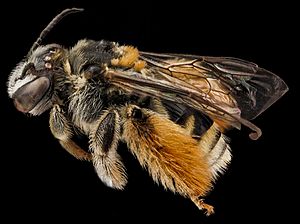Exomalopsis facts for kids
Quick facts for kids Exomalopsis |
|
|---|---|
 |
|
| Exomalopsis similis | |
| Scientific classification |
|
| Kingdom: | Animalia |
| Phylum: | Arthropoda |
| Class: | Insecta |
| Order: | Hymenoptera |
| Family: | Apidae |
| Tribe: | Exomalopsini |
| Genus: | Exomalopsis Spinola, 1853 |
| Species | |
|
~90 |
|
Exomalopsis is a group of bees that belong to the Apidae family, which includes many well-known bees like honeybees and bumblebees. These bees are found in the Western Hemisphere, meaning they live in North, Central, and South America.
Contents
How Exomalopsis Bees Live and Build Nests
Exomalopsis bees are known for building their nests together. This means several female bees might share the same main entrance to a nest, even if they each have their own private areas inside.
Amazing Underground Homes
Scientists have studied how different Exomalopsis species build their homes. For example, a bee called E. aburraensis digs tunnels that can go over a meter (more than 3 feet) deep into the ground! From this main tunnel, many smaller paths branch off, leading to special rooms called cells. This is where the bee larvae (baby bees) grow and develop. Sometimes, these bees even build their nests close to where people keep honeybees.
Another species, E. nitens, found in California, uses cracks in dry soil to start its home. It digs chambers underground where it collects a pile of food. The mother bee then lays her eggs on top of this food pile. The young larvae eat the food as they grow, and then they change into a resting stage called a pupa before becoming adult bees.
Nests in Dirt Roads
Some Exomalopsis bees, like E. globosa and E. similis, have been seen making their nests in dirt roads, especially those made of reddish clay. A female bee, ready to lay eggs, will gather food in a cell at the very end of a tunnel. She shapes this food into a neat loaf and then lays a single egg on it. After laying the egg, she seals the cell. This keeps the larva safe and gives it all the food it needs to grow inside.
Unwanted Guests: Cuckoo Bees
Just like some birds, certain bees are "cuckoo bees." These bees are kleptoparasites, which means they don't build their own nests or collect their own food. Instead, they sneak into the nests of other bees, like Exomalopsis, and lay their eggs there. The baby cuckoo bees then eat the food that the Exomalopsis mother bee collected for her own young.
Several types of cuckoo bees are known to use Exomalopsis nests. These include cuckoo bees from the groups Brachynomada, Nomada, Paranomada, and Triopasites. For instance, a recently discovered cuckoo bee called Nomada medellinenses moves into the nests of E. aburraensis to lay its eggs.
Other Parasites: Wasps
Exomalopsis bees can also be hosts for parasitoid wasps. These wasps lay their eggs on or inside other insects. When the wasp eggs hatch, the larvae eat the host insect. For example, the wasp Pseudomethoca bethae parasitizes E. solani bees. Also, at least two species of Timulla wasps are known to use E. fulvofasciata bees as hosts.
About Exomalopsis Species
As of 2007, scientists had identified and named almost 90 different species within the Exomalopsis group. However, there are likely many more species that have not yet been officially described or named.
Some of the known species include:
- Exomalopsis aburraensis
- Exomalopsis analis
- Exomalopsis mellipes
- Exomalopsis pulchella
- Exomalopsis similis
- Exomalopsis solani
- Exomalopsis fulvofasciata
Images for kids




